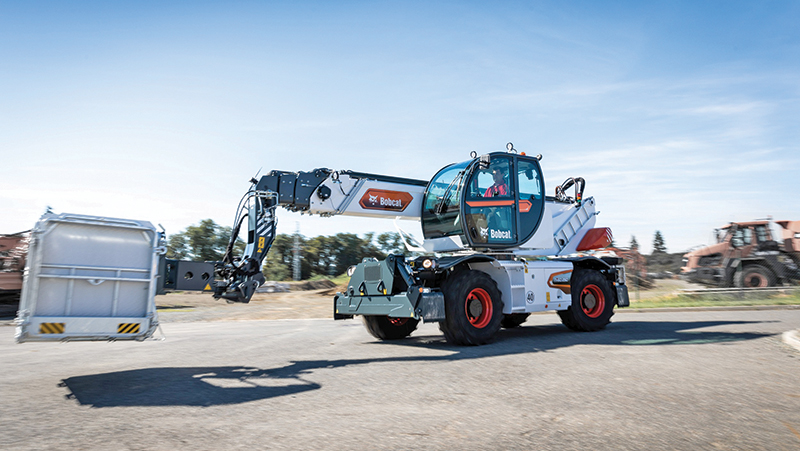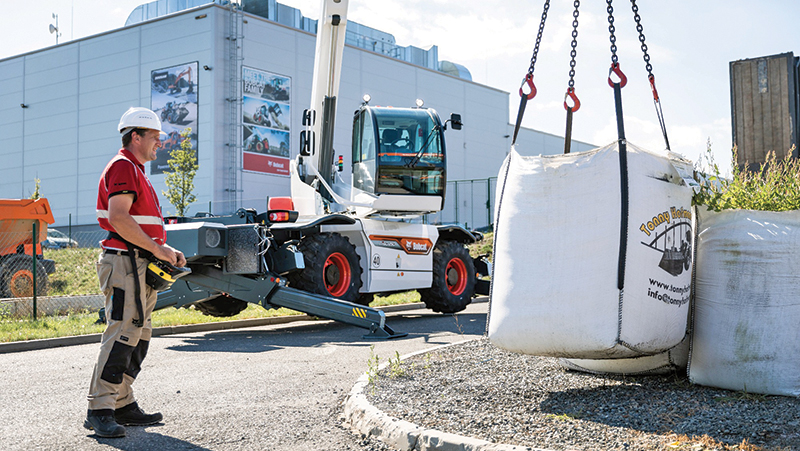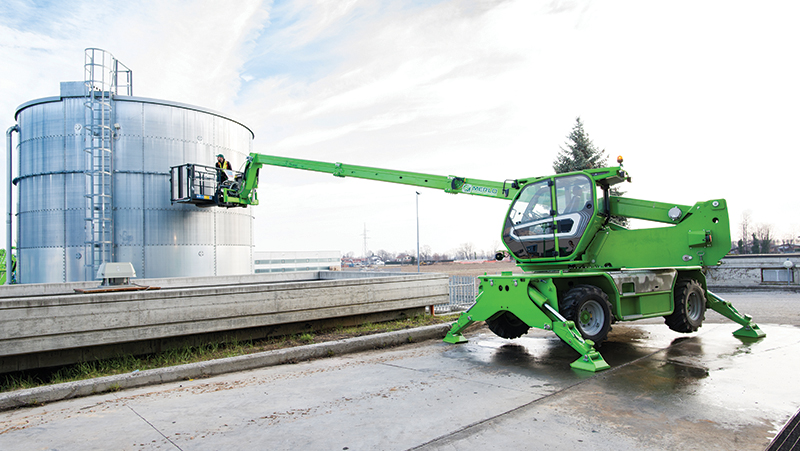The Handler
Mots-clés: Telehandlers
Tags:
Telehandlers are prized for their versatility and wide range of applications, but contractors can still look to get more out of their machines as OEMs launch new rotating telehandlers.

When it comes to moving material and working at height, telehandlers are uniquely versatile and hence found on almost every construction site, from a single villa plot up to a mega project. With multiple attachments and sophisticated onboard electronics and controls, telehandlers can play many roles.
JCB launched its first loadall in 1977, the JCB 520, and since then has sold more than 270,000 telehandlers. It currently offers at least 15 telehandler variants, from the 516-40, the world’s smallest telehander, to the new 5.5-21, a rotating telehandler with a maximum reach of 20.5m and lifting capacity of 5,500kg.
“Our market share of over 50% in 2019 across the MENA region is testament to our leadership in the telehandler segment. One of the key factors which has enabled us to achieve market leadership both regionally and globally is our long-standing history and constant innovation in our products over the years,” says Manaaz Sheriff, JCB District Manager, Middle East.
Top-selling machines in the region include the 531-70, 535- 125, 540-170 and 540-200.
“The largest-selling among these is undoubtedly the 540-170, followed by the 535-125. In fact, the 540-170 is our largest selling telehandler globally,” says Sheriff. “The key reason for the popularity of the 540-170 and 535-125 is the versatility of these machines to do most of the material handling jobs in a construction site.”
“In addition to this, we offer a wide range of attachments like sweeper collectors, man platforms, earth drills, jibs and much more. The durability, ease of use, operator comfort and the resale value of this product are of course other added values our products offer.”
The 540-170 is powered by a JCB DIESELMAX engine and the powertrain is designed and manufactured in-house. Boom extensions are managed hydraulically, which results in increased productivity and lower maintenance costs, says Sheriff, while the machines are built with a one-piece chassis side plate which provides excellent strength and torsional stiffness.

“Booms are U-shaped and made of a single closing plate, reducing joints and stress points, adding to the structural integrity of the machine. Our patented Adaptive Load Control system generates progressive control complying to EN15000, and our narrow chassis design offers increased visibility for high productivity and increased safety.”
As with any material handling machinery, safety is paramount. An important factor to ensure safe operation of a telehandler is for the operator to level the machine based on the underfoot conditions on-site, with the help of stabilisers and onboard aids.
Apart from various material handling applications on construction sites, JCB telehandlers are also widely used in facility maintenance work with the use of man platform attachments, Sheriff says. They are also used in dairy farms across the region to handle fodder, and in oil & gas pipe-laying applications, equipped with forks, jibs and special purpose buckets. The sweeper collector attachment is also widely used by facility management companies and municipalities.
New roto range
Bobcat’s top-selling telehandler is the 18m T40.180SLP. Bobcat has been number two in this segment in the GCC for several years, and number one in some countries in the region, says Gaby Rhayem, Regional Director Middle East and Africa for Doosan Bobcat. Telehandlers in the GCC are primarily used for handling and lifting jobs in construction.

Remote control can allow the operator to carry out precise movements and positioning of loads
“Customers really appreciate the unbeatable stability of the T40.180SLP, which can lift 4 tonnes up to 14m when on stabilisers, or can lift a heavy load up at 17m when on tyres, allowing great mobility,” Rhayem notes. “We also have a unique and patented feature, the Boom Positioning System, which allows the operator to move the load right and left at height without moving the machine, even on stabilisers.”
The man platform is the most used attachment in the GCC after traditional forks and buckets. “We are having great success, as our system is quite competitive and the remote control can also be used to move the boom to a location where the operator has better visibility,” says Rhayem. “On top of that, if you combine the rotation and extension of the platform with our Boom Positioning System, this is a perfect combo for precise placement of workers at height and more mobility without having to move the machine.”
Late last year, Bobcat launched a new range of rotating telehandlers, including the five-tonne, 21m TR50.210, which Rhayem believes will be a good fit for the region, along with the larger 25m machine. Rotating telehandlers are not widely used in the region, with many contractors using mobile cranes instead. “At the moment, there is a price advantage and it is easy to find and rent these products instead of buying.”
Nevertheless, the Roto TLS is much easier to control than a mobile crane and can carry out many other functions, such as loading with forks, using a bucket, using a man platform, taking a load on it, and using a broader range of attachments, he says. Dedicated applications and missions include fire fighters, large contractors and construction companies who build massive villa projects and other large developments.
Italian telehandler specialist
Recognisable with distinctive green paint jobs, Merlo produces a range of telehandlers – from compact models, medium duty and panoramic with stabilisers, to high-capacity panoramic telehandlers – as well as a rotary model. The company is currently overhauling its full range of machines sold in markets outside Europe, including for the Middle East.

Building around 90% of its components in-house allows Merlo to produce innovative machines to its own high specifications, says Mattia Bodino, Marketing & Communication Manager. The main focus is on safety, comfort, and productivity.
“What sets us apart is that we are a manufacturer of telehandlers – everything is designed in-house, starting from the axle, the boom, the cab, the chassis. What we buy is the engine, the hydraulic pumps, the tyres, some of the gears – all the rest is made in Merlo. That means everything is designed to be our ideal solution. That’s why, compared to the competition, our machine is more compact, with a better visibility and ease of use. Today, we have around 90 patents registered for our range of machine, and we are a driver of the telehandler sector with our innovations.”
Key features of Merlo telehandlers include excellent all-round visibility; hydrostatic transmission, which means the machine is easy to use; and the boom is responsive to controls and makes very precise movements. “You can give this machine to anybody and after two minutes they can use it,” says Bodino.
The company’s top-selling machine in the GCC is the P40.17EE, with 4,000kg maximum capacity, 17m maximum lifting height and front stabilisers, one of four machines in the new Panoramic range. Main features of the new range include a new high-comfort cab, new axles, completely revamped stabilisers and chassis, and the Attachment Recognition System, a technology that increases safety standards without affecting performance.
Key attachments include forks for moving material, buckets for excavation, platforms, hooks and occasionally a fly jib for extra reach, making the P40.17EE a great general purpose machine on a job-site, says Bodino. The onboard Attachment Recognition System prevents overloading, to improve site safety and reduce potential damage to the machine.

Telehandlers are prized for their flexibility on-site, whether moving material or putting workers in place with a platform.
Merlo has also sold some rotary telehandlers in the Middle East, and Bodino believes it’s a growth segment. “It’s an interesting machine with very high efficiency, though it can be difficult to introduce this to new customers, as they are typically looking for very simple machines and not everyone can see its potential.”
Due to productivity and durability, Merlo telehandlers have strong resale value, says Bodino. “We still have more room to grow in the Middle East, but the market is more and more coming to see the value of the Merlo machines.”
Vidéos
Bobcat EMEA Launches The New Generation R-Series B730 Backhoe Loader For The Middle East And Africa
Al Qahtani Vehicle & Machinery Showcasing LuiGong Machines In Saudi Arabia
Masaha Global Is Offering The Luxurious & Eagle Eye Shaped Foton Aumark Super Truck

























